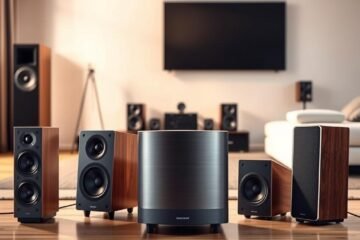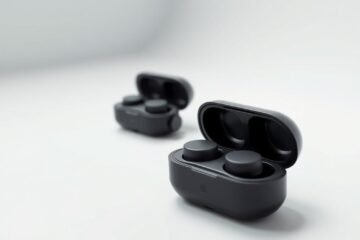Did you know that 87% of running accidents happen because athletes can’t hear their surroundings? This shocking statistic shows why bone conduction headphones are a game-changer for active people in 2025.
These headphones don’t block your ears like regular earbuds do. Instead, they send sound through vibrations in your cheekbones. You get crystal-clear audio while staying alert to traffic, other runners, and dangers.
Runner’s World and TechRadar have tested many models. They found big improvements in comfort, fit, and sound quality. Their tests with runners and cyclists over months prove these headphones are superiorly safe without losing sound quality.
If you’re looking for the best bone conduction headphones 2025 or need ones for runners and cyclists, this guide has you covered. It includes everything from affordable options to top-of-the-line models that will change your active life.
Want open ears without ear tips? Compare with open-ear audio glasses for everyday use.
Key Takeaways
- Open-ear technology maintains situational awareness while delivering high-quality audio
- Extensive real-world testing confirms superior comfort and performance for active users
- Safety benefits make these devices essential for runners and cyclists in 2025
- Wide range of options available from budget-friendly to premium models
- Technology improvements have revolutionized outdoor sports audio experience
What Are Bone Conduction Headphones and How They Work
Bone conduction headphones don’t put sound in your ears like regular headphones do. Instead, they use vibrations that go through your cheekbones. This method is safe and lets your ears stay open to other sounds.
This technology works because sound waves can travel through bone. When you talk, you hear your voice through both air and bone. Open-ear audio technology uses this to offer a new way to listen.
These headphones have special parts that sit on your cheekbones. They turn sound into vibrations. These vibrations then go through your skull to your inner ear, skipping your eardrum.
Your inner ear, the cochlea, picks up these vibrations. It turns them into signals your brain understands as sound. This happens without blocking your natural hearing.
The big plus of bone conducting technology is that it’s non-invasive. You can hear everything around you because nothing blocks your ears. This is great for runners and cyclists who need to stay alert.
The transducers in good bone conduction headphones make very slight vibrations. You might not even feel them. Modern designs have gotten rid of the annoying tickle some old models had.
This tech is also good for people with some hearing problems. It goes around the outer and middle ear, helping those with conductive hearing loss. But it works best if your inner ear is okay.
The science behind bone conduction explains why it sounds so clear. Bone is better at carrying sound waves than air in some ranges. Your skull helps make the sound louder as it goes to your cochlea.
Knowing how bone conduction technology works helps you see why these headphones are different. They don’t press on your ears, keep you aware of your surroundings, and don’t hurt your ear canals. The open-ear audio technology offers a unique listening experience that’s both clear and safe.
Benefits of Bone Conduction Headphones for Runners and Cyclists
When you’re running or cycling outdoors, it’s key to stay aware of your surroundings. Open ear headphones send sound through bone vibrations while keeping your ears open. This design offers a great mix of fun and safety.
These headphones boost safety during outdoor activities. You can hear cars, other athletes, and dangers while listening to music or podcasts. Running safety headphones let you catch car horns, bike bells, and shouts that regular earbuds miss.
In busy cities, this situational awareness audio tech is super helpful. It keeps you safe at traffic lights, bike paths, and crowded parks. Many runners feel safer during early morning or evening runs when it’s dark.
Comfort is another big plus for active people. Bone conduction headphones don’t press on your ears like earbuds do. This means no ear pain during long workouts. It also lowers the risk of ear infections from trapped moisture and bacteria.
Wearing these headphones for hours is easy. Marathon runners and long-distance cyclists can use them without ear fatigue. They’re light and spread pressure on your cheekbones, not your ears.
These headphones are great for many sports. They work well with:
- Cycling helmets – No issues with helmet straps or padding
- Sunglasses – Fits with all eyewear styles
- Safety equipment – You can wear ear protection when needed
- Communication devices – Works with radio systems for group activities
They’re also weather-resistant. Most models have IPX4 to IPX8 ratings, so they’re safe from sweat, rain, and humidity. You can train in any weather without worrying about damage.
Being able to hear my surroundings while listening to music has changed my running. I feel safer and more connected.
These headphones also help with performance. They let you hear your breathing and footstrike rhythm. This feedback helps improve your technique.
They also make social activities better. You can hear and talk with fellow athletes, coaches, or training partners. Group rides and running clubs are more fun without needing to take out your earbuds.
Check our Best Wireless Gaming Headphones for more options
Bone Conduction vs Traditional Headphones: Complete Comparison
The debate between wireless bone conduction headphones and traditional earbuds focuses on key factors. Traditional headphones offer better sound quality. But, bone conduction tech has unique benefits for certain situations and users.
Traditional earbuds and headphones give you better sound than bone conduction ones. They block out noise and offer richer sound. But, you lose awareness of your surroundings.
Open-ear headphones with bone conduction tech are safer and more comfortable. They let you hear what’s going on around you while listening to music or podcasts.
| Feature | Bone Conduction | Traditional Headphones | Traditional with Transparency |
|---|---|---|---|
| Sound Quality | Good for voice, limited bass | Excellent across all frequencies | Excellent with adjustable ambient |
| Safety Awareness | Complete environmental awareness | Completely isolated | Adjustable ambient sound |
| Comfort | No ear canal pressure | May cause ear fatigue | May cause ear fatigue |
| Battery Life | 6-10 hours typical | 4-8 hours with case charging | 4-6 hours with ANC/transparency |
| Water Resistance | IP67-IP68 common | IPX4-IPX7 typical | IPX4-IPX7 typical |
Many top earbuds now have transparency modes. These modes mix ambient sounds with your music. But, they can’t beat the natural hearing of bluetooth bone conduction headphones.
Sports headphones are a key area of competition. Traditional earbuds are better for workouts. But, bone conduction is safer for outdoor activities.
Prices vary between the two. Basic bone conduction headphones start at $30-50. Quality traditional earbuds also start at similar prices. But, top bone conduction models can cost $150-200, like high-end traditional ones.
Your choice depends on what matters most to you. Go for bone conduction for safety and comfort. Choose traditional headphones for the best sound quality and isolation.
How to Choose the Best Bone Conduction Headphones
Choosing the right bone conduction headphones depends on your activity level, budget, and what you need. Knowing these factors helps you pick the best for you.
Water and Dust Resistance is key for active users. The *IP rating* shows how well headphones handle moisture and dirt. Waterproof bone conduction headphones with IP67 ratings can handle sweat and rain. IP68 models are perfect for swimming.
Most waterproof sports headphones have IPX4 to IPX7 ratings. IPX4 is good for jogging in light rain. IPX7 models can handle being underwater for a short time, great for intense workouts.
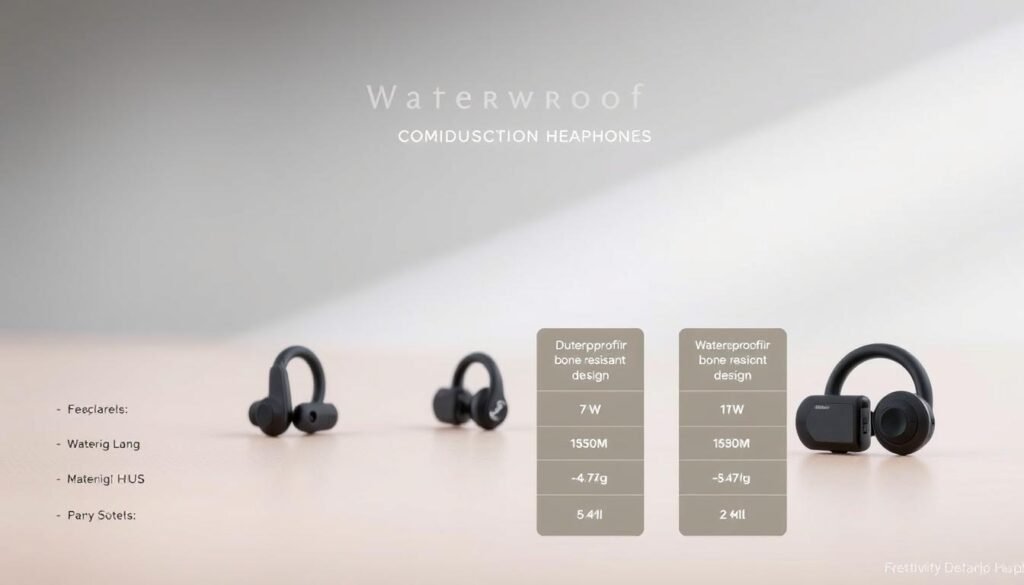
Battery Life and Charging Options matter a lot. Good headphones last 6-10 hours without needing a charge. Think about how long you work out and choose wisely.
Fast charging is a big plus. Many top models give 1-2 hours of playtime from just 15 minutes of charging. USB-C charging is faster than older micro-USB.
Connectivity and Controls make a big difference. Bluetooth 5.0 or newer saves battery and keeps connections strong. Being able to pair with multiple devices is handy.
Built-in microphones let you talk hands-free. Physical buttons are better than touch controls, even when your hands are wet. Being able to use voice assistants makes things easier.
Fit and Comfort Considerations are important for wearing them a lot. The band should spread the weight evenly. Adjustable designs fit different head sizes.
Lightweight headphones are less tiring during long activities. Silicone or rubber ear hooks keep them in place without discomfort. Make sure they fit with your helmet or sunglasses.
Special Considerations for Different Users help you choose. Hearing impaired headphones are great for those with hearing loss. They offer better sound and volume.
Cyclists need to hear traffic sounds. Runners want headphones that stay in place. Swimmers need headphones that work underwater.
| Price Range | Key Features | Best For | Expected Battery Life |
|---|---|---|---|
| $30-60 | Basic water resistance, standard sound | Casual users, beginners | 4-6 hours |
| $80-120 | IPX7 rating, good battery, controls | Regular exercisers | 6-8 hours |
| $150-200 | Premium sound, fast charging, IP68 | Serious athletes | 8-10 hours |
| $200+ | Advanced features, superior build quality | Professional use | 10+ hours |
Budget Planning helps you decide what’s important. Basic models around $50 are good for occasional use. Mid-range options ($80-150) are best for regular exercisers.
Premium models over $150 offer top quality and features. Think about how often you use them and how intense your activities are when setting your budget.
Top Premium Bone Conduction Headphones
High-end bone conduction headphones mix top performance, durability, and cool design. These models lead the way in bone conduction tech. They come with advanced features that make their high price worth it.
These top models give you the best sound and comfort. They’re made for athletes who need the best during tough workouts.
Shokz OpenRun Pro – Best Overall
The Shokz OpenRun Pro is the top in bone conduction tech. It has dual drivers and advanced sound processing for amazing audio.
Key Features:
- 12-hour battery life for long workouts
- Dual drivers for rich sound
- Secure titanium frame for a perfect fit
- EQ modes in app for custom sound
- Clear calls with noise cancellation
Pros: Great battery life, top sound quality, comfy for long wear, solid build.
Cons: Expensive, a bit heavy.
Best For: Serious athletes who want the best bone conduction experience.
Shokz OpenFit – Best Premium Hybrid
The Shokz OpenFit is a mix of earbuds and open-ear tech. It gives you better bass and keeps you aware of your surroundings.
Key Features:
- Hybrid design with better bass
- 28-hour battery with case
- Secure ear hook for active use
- IPX5 water resistance
- Touch controls and voice assistant
Pros: Great bass, long battery, comfy fit, good for many activities.
Cons: More expensive, charging case is big.
Best For: Athletes who want great sound and awareness, great for indoor and outdoor use.
Mojawa Run Plus – Best for Long Runs
The Mojawa Run Plus is perfect for long runs. It’s a strong competitor to aftershokz headphones with features for ultra-distance athletes.
Key Features:
- 16-hour battery for long use
- Lightweight titanium build
- IP67 waterproof for swimming
- Magnetic charging for quick top-ups
- Memory foam for extra comfort
Pros: Long battery life, very comfy, fully waterproof, light.
Cons: Hard to find, fewer features than others.
Best For: Ultra-marathoners and triathletes needing long battery life and waterproofing.
Best Value Bone Conduction Headphones
Looking for great bone conduction headphones that won’t empty your wallet? These mid-range options pack a punch without the high cost. They offer solid connectivity, long battery life, and comfy designs that match the best.
The best bone conduction headphones 2025 show that you don’t need to spend a lot to get quality. They’re perfect for runners and cyclists who want great sound without the hefty price tag.
Shokz OpenRun – Best Value for Money
The Shokz OpenRun is a top pick for those on a budget. It offers top-notch sound, 8-hour battery life, and fast charging.
Key Features: It’s waterproof, made of titanium, and charges fast. You get 1.5 hours of playtime in just 10 minutes. It’s also super comfy during tough workouts.
Pros: Great value, reliable Bluetooth 5.1, and it’s light at 26 grams. Cons: Bass isn’t as strong as pricier models, and color choices are limited.
Best For: Athletes on a budget who want top bone conduction tech without missing out on key features.
AfterShokz Aeropex – Lightweight Classic
The AfterShokz Aeropex is a favorite among bone conduction fans. It’s super light at 26 grams and has been a hit for years.
Key Features: It has a titanium design, lasts 8 hours, and is water-resistant. The magnetic charging port keeps things secure, and its design lets you stay aware of your surroundings.
Pros: It’s a proven winner, very comfy for long use, and well-made. Cons: It uses older Bluetooth 5.0, and bass isn’t as strong as newer models.
Best For: Those who love the classic aeropex look and want a reliable, tested bone conduction option.
Budget-Friendly Bone Conduction Options
Affordable wireless bone conduction headphones make great sound accessible to all. These models offer top-notch sound and key features at a lower cost. You don’t have to spend a lot to enjoy the benefits of bone conduction.
Looking for deals, you’ll find today’s budget options are surprisingly good. They often come with water resistance, secure fits, and good battery life. It’s all about knowing what you’re willing to give up for savings.
Haylou PurFree BC01 – Best Budget Option
The Haylou PurFree BC01 is a top pick for those on a budget in the bluetooth bone conduction world. It’s light, weighing just 27 grams, and packed with features that match pricier models.
Key features include an 8-hour battery and IP67 water resistance. Its titanium frame is tough for workouts. You can easily switch between devices with dual connectivity.
Pros: Great value, comfy fit, strong water protection, reliable connection. Cons: Bass could be better, slightly longer to charge than pricier models.
Best for: New to bone conduction or budget-conscious athletes wanting quality without the high cost.
Eixpdaye S12 – Best Affordable Backup
The Eixpdaye S12 is a solid second pair or intro to open ear headphones. It offers consistent quality and build for its price.
Its titanium build and Bluetooth 5.0 connection are reliable. The 6-hour battery is good for workouts. It’s water-resistant for sweat and rain.
Pros: Cheap, reliable, comfy, clear sound. Cons: Limited water resistance, shorter battery, basic features.
Best for: A backup pair or trying bone conduction without spending a lot.
YouthWhisper Lite – Best Entry-Level Choice
The YouthWhisper Lite is simple and easy for beginners. It focuses on basic bone conduction benefits without extra features.
It has easy controls and is light for comfort during long sessions. It pairs quickly with most devices.
Pros: Very cheap, easy to use, light, quick setup. Cons: Basic sound, fewer features, shorter battery.
Best for: Beginners who want simplicity and affordability over advanced features and sound.
Specialized Bone Conduction Headphones
Most bone conduction headphones are for general fitness. But, specialized models are made for specific activities. They have features like situational awareness headphones for cyclists and water sports fans. These headphones are durable, have controls for activities, and adapt to the environment.
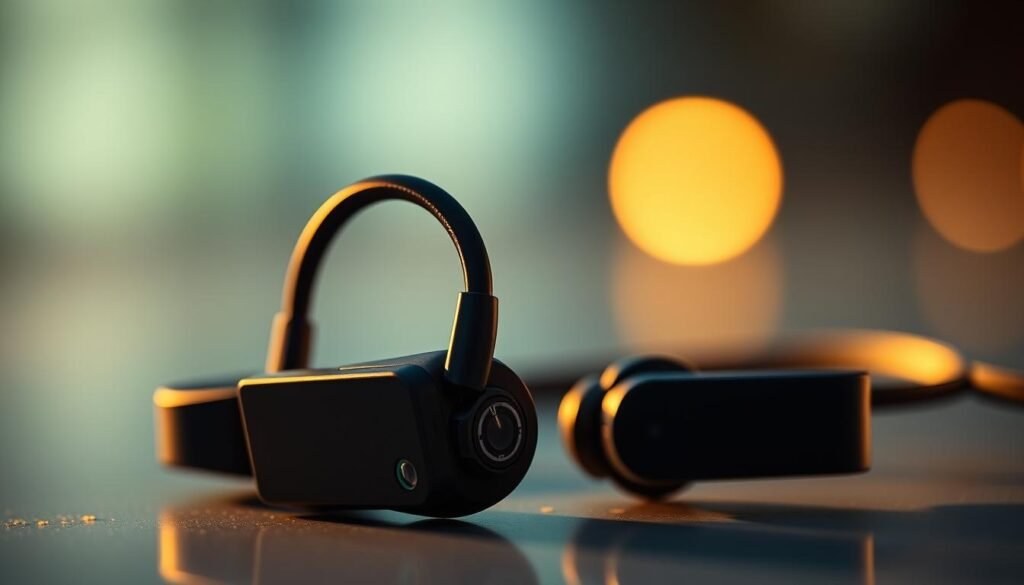
Philips A6606 – Best for Cyclists
The Philips A6606 is the top pick for bone conduction headphones for cyclists. It’s designed to resist wind, keeping audio clear during fast rides. It fits under cycling helmets without pressure.
Key features include controls that work with cycling gloves and a titanium frame. It has an 8-hour battery and bass that cuts through wind.
Pros: It’s helmet-friendly, glove-friendly, and has great wind resistance. Cons: It’s pricier and has fewer color options.
Best for: Road cyclists, mountain bikers, and commuters who need good audio and safety during rides.
Naenka Runner Diver – Best Waterproof (IP68)
The Naenka Runner Diver is the best for waterproof bone conduction headphones. It’s IP68 rated, so it can go up to 2 meters deep. It’s great for bone conduction for swimming and water sports.
Key features include 32GB storage and Bluetooth. The charging port is sealed against water. Audio is clear underwater thanks to special tuning.
Pros: It’s fully waterproof, has storage, and audio is optimized for swimming. Cons: It’s bulkier and has a shorter battery life underwater.
Best for: Swimmers, triathletes, and water sports fans who need good audio in water.
Complete Comparison Table of All 10 Models
Choosing the right bone conduction headphones is easier when you compare all models side by side. This detailed comparison helps you find the best bone conduction headphones 2025 that fit your needs and budget.
The table below shows key specs for all ten models. You can easily see which bone conduction headphones for runners have the features you want most.
| Model | Battery Life | Water Resistance | Weight | Price Range | Best For |
|---|---|---|---|---|---|
| Shokz OpenRun Pro | 10 hours | IP55 | 1.06 oz | $180-200 | Premium performance |
| Shokz OpenFit | 7 hours | IP54 | 0.92 oz | $180-200 | Hybrid comfort |
| Mojawa Run Plus | 12 hours | IPX6 | 1.13 oz | $150-170 | Long-distance running |
| Shokz OpenRun | 8 hours | IP67 | 0.92 oz | $130-150 | Best value overall |
| AfterShokz Aeropex | 8 hours | IP67 | 0.92 oz | $160-180 | Lightweight classic |
| Haylou PurFree BC01 | 8 hours | IPX7 | 1.23 oz | $50-70 | Budget-friendly option |
| Eixpdaye S12 | 6 hours | IPX5 | 1.06 oz | $40-60 | Affordable backup |
| YouthWhisper Lite | 5 hours | IPX5 | 0.99 oz | $30-50 | Entry-level users |
| Philips A6606 | 9 hours | IP67 | 1.27 oz | $100-120 | Cycling enthusiasts |
| Naenka Runner Diver | 10 hours | IP68 | 1.34 oz | $120-140 | Swimming and water sports |
Understanding these specs helps you make better choices. Battery life varies from 5 to 12 hours. Longer-lasting models are great for long activities.
Water resistance levels differ a lot. Waterproof sports headphones with IP67 or IP68 ratings are best for intense workouts or swimming.
Weight matters, even if it seems small. Models under 1 ounce are the most comfortable for long wear.
Prices reflect quality and features. Premium models cost more but offer better open-ear audio technology and durability.
Think about your main activities when picking. Runners should look for lightweight designs with good battery life. Cyclists need models that enhance situational awareness.
Looking for dedicated headsets? Don’t miss our Best Wireless Gaming Headphones for Gameplay – 2025,
covering the top wireless picks for immersive gaming sessions.
Key Features to Look for in 2025
Knowing the latest tech helps you pick the best bone conduction headphones. The bone conduction technology has changed a lot this year. Now, features once seen as future ideas are in everyday products.
Today’s headphones have better sound thanks to new transducer tech. Wireless bone conduction headphones now have systems that cut down sound leakage by up to 50%. This means you can hear your music better without bothering others.
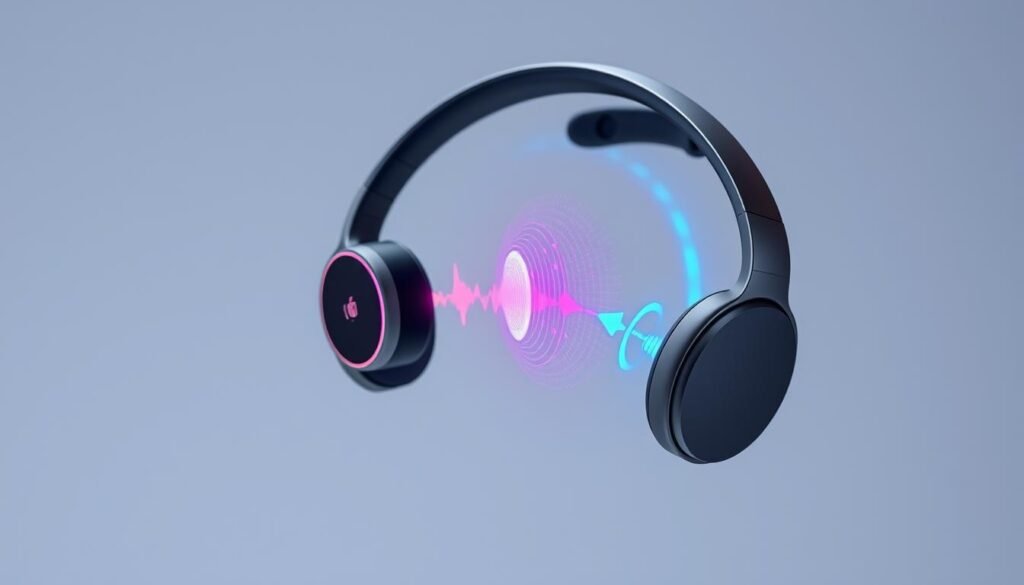
Better battery life is another big step forward. Top models now last 12+ hours without needing a recharge. Some even go up to 16 hours. And, they charge fast, giving you 2 hours of listening with just 10 minutes of charging.
Water resistance has also gotten better. The best bluetooth bone conduction headphones can now handle being fully submerged. This is great for swimmers and athletes who play in extreme weather.
“The mix of AI-powered voice assistants with bone conduction tech offers a hands-free experience that old headphones can’t match.”
Smart features are now expected, not just extra perks. Look for headphones with:
- Multi-device connectivity for easy switching between devices
- Customizable EQ settings through apps for your perfect sound
- Advanced touch controls for easy use
- Voice assistant integration for better voice commands
Fitness tracking is the latest in open-ear audio technology. Top models track your heart rate, workout intensity, and offer coaching feedback through audio.
Microphone tech has also improved for clearer calls. Dual-microphone arrays with noise cancellation make your voice clear, even in windy conditions. This is key for runners and cyclists who need to talk while moving.
Materials have also evolved for better comfort and durability. Titanium alloy frames are flexible yet strong. Memory foam and ergonomic designs make long wear comfortable.
When choosing 2025 models, think about what you do most. Runners need secure fit and sweat resistance. Cyclists want good awareness and wind noise reduction. Knowing these tech advances helps you choose headphones that really improve your active life.
For choosing right Headphones check our Best Sweatproof Bluetooth Headphones for outdoor
How to Use Bone Conduction Headphones Safely
When using running safety headphones outdoors, safety comes first. Bone conduction tech helps you stay aware of your surroundings. But, it’s important to follow guidelines to protect your hearing and safety.
It’s key to keep the volume right. Aim for 60-80% of the max to avoid hearing damage. Bone conduction headphones let you hear outside sounds better at these levels.
- Road running: 60-70% maximum volume
- Trail running: 70-80% maximum volume
- Cycling in traffic: 50-60% maximum volume
- Indoor workouts: 70-85% maximum volume
Situational awareness headphones are great for staying alert. Use only one earbud when you can. This is very important for activities like cycling or running near traffic.
Weather affects safety. Lower the volume in rain or snow because you might miss important sounds. Wind can also mess with your audio and your ability to hear dangers.
The key to safe headphone use during exercise is finding the perfect balance between audio enjoyment and environmental awareness.
Activity-Specific Safety Guidelines:
For road running, watch out for traffic and avoid headphones in busy times. Choose well-lit paths and wear reflective clothes. Your situational awareness audio should let you hear important sounds like car horns.
Cyclists need to know the law about headphones. Check local rules before you ride, as some places ban headphones.
Trail runners can use higher volumes because there’s less traffic. But, stay alert for other people, animals, and terrain changes. Watch out for falling branches or unstable ground.
Special Considerations for Hearing Impaired Users:
Hearing impaired headphones users get a lot from bone conduction tech. It can help bypass damaged parts of the ear. But, talk to an audiologist to set the right volume and use.
For those with hearing loss, these headphones can help. They send vibrations to the inner ear, which might improve hearing during activities.
Best Practices for Safe Usage:
- Test your headphones in safe environments before using them during activities
- Regularly clean the contact points to ensure optimal sound transmission
- Take breaks every hour during extended use to prevent fatigue
- Monitor your hearing health with regular audiologist checkups
- Replace worn or damaged headphones immediately
Always be aware of your surroundings. Never wear headphones when crossing busy streets, in construction zones, or during emergencies. Your safety depends on being fully alert in risky situations.
Legal rules about headphones vary by place and activity. Check local laws to avoid fines or legal trouble.
Have a plan for emergencies. Use signals with friends and carry ID when exercising alone. Consider headphones that can be quickly removed in emergencies.
Keep your headphones clean and store them right to make them last longer. Clean them after each use, after sweaty workouts or in bad weather.
Conclusion
Bone conduction headphones are a game-changer for active people. They let you enjoy great sound without risking your safety. When picking the best for 2025, think about what you need and how much you can spend.
The Shokz OpenRun Pro offers top-notch sound and lasts long. If you’re on a tight budget, the Haylou PurFree BC01 is a great choice. Cyclists might prefer the Philips A6606 for its special features.
These headphones are perfect for sports because they let you hear everything around you. They’re great for runners and cyclists who need to stay alert. You can listen to music or podcasts while staying aware of your surroundings.
Investing in good bone conduction tech is smart. It boosts your safety and performance. Look for brands known for quality and support. Think about what you do, what you want, and your budget when you choose.
The future of sports audio is all about bone conduction. It makes your workouts better and keeps you safe. Try it out and see how it changes your active life for the better.
Bone conduction isn’t the only alternative. For a clear comparison of traditional options, see our
5 Essential Differences: Over-Ear vs. In-Ear ANC Headphones.
Related: Audio Glasses
Explore our Best Audio Glasses (Fall 2025) for open-ear music, clearer calls, and smart-assistant control.





